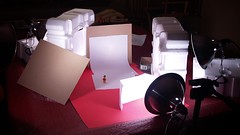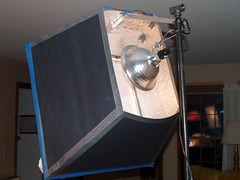First off, a small to medium solution: Buy more lights and grab some readily available items to diffuse the light. The Poor Man's Lighting Setup:

This next solution is one I created when building my hobby tables: DIY Light Diffuser boxes. These can be used for portraits, as well as medium sized MOCs (anything under 4'x4' in area is ideal). I built two of these:


For more images, navigate the photostream.
For pictures of the build process, here are those:








Sorry, there are no pictures of the hood design and assembly. Not all screens are built to the same size, so you will need to measure and cut based on your screen's particular dimensions. The top sheet on my box is attached at a 90 degree angle, and everything else conforms to that with a smaller opening in the back.
My advice for people doing large MOC shooting is to buy some posterboard for backdrops. Colored or white paper is fine, though white can be used for reflecting light as well... just pick what best matches your project. I keep a few sheets of blue, green, and red/yellow reversible sheets on hand.
Alternatively, you could purchase a roll of white butcher paper and tape some of it together and tape or hang it somewhere for a larger backdrop.
If you are really strapped for cash, just create a paper box and tape it around the flash on your camera. You'll impress yourself with the results I imagine!!
My next project will be to build a giant light reflector/diffuser big enough to be used with a large Lego creation such as a big castle or city. Feedback or suggestions are welcome!
My current belief is that it can be done economically using hemmed ripstop fabric and tent poles (fiberglass poles). I imagine it'd look like a large pringle chip that I could bend and wrap around an area so wide-scale diffusion could be achieved. I've yet to source the materials, but if anybody knows where to get some of these things, I would appreciate that.